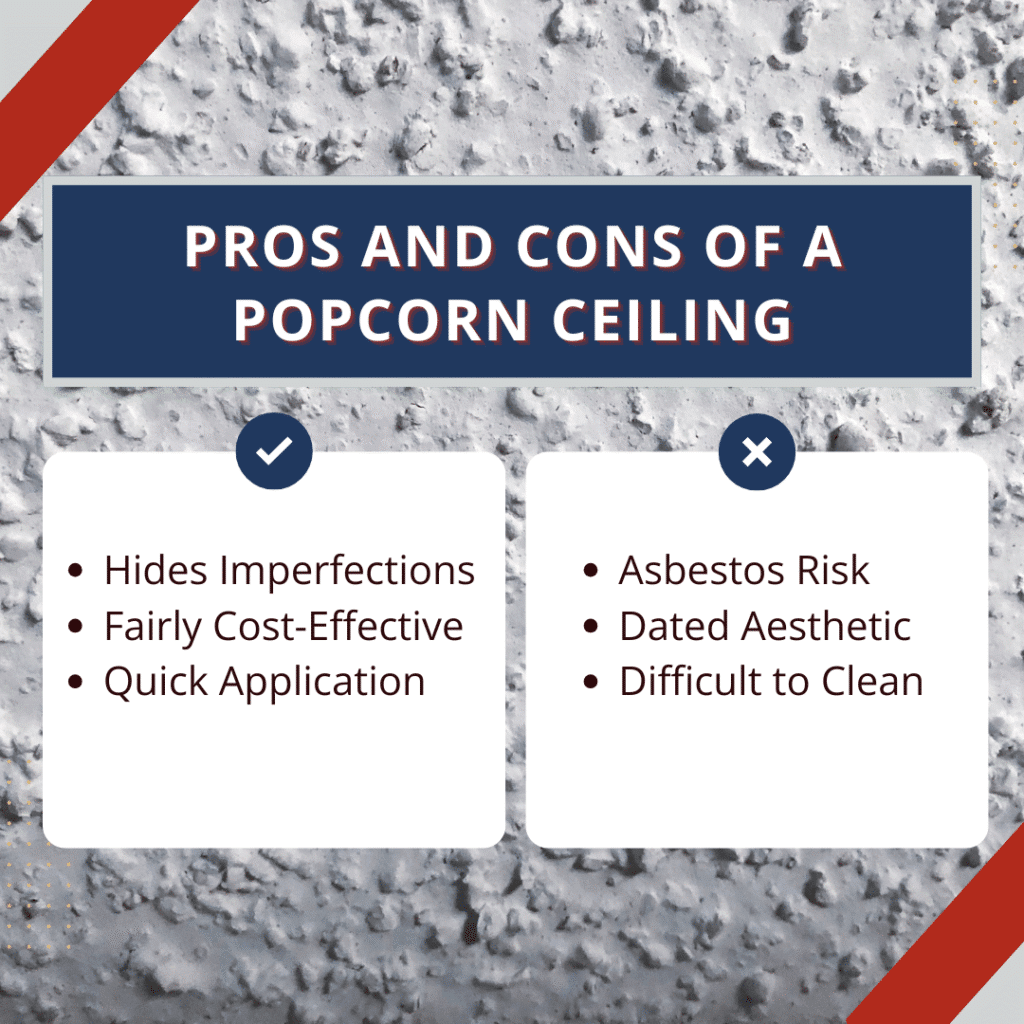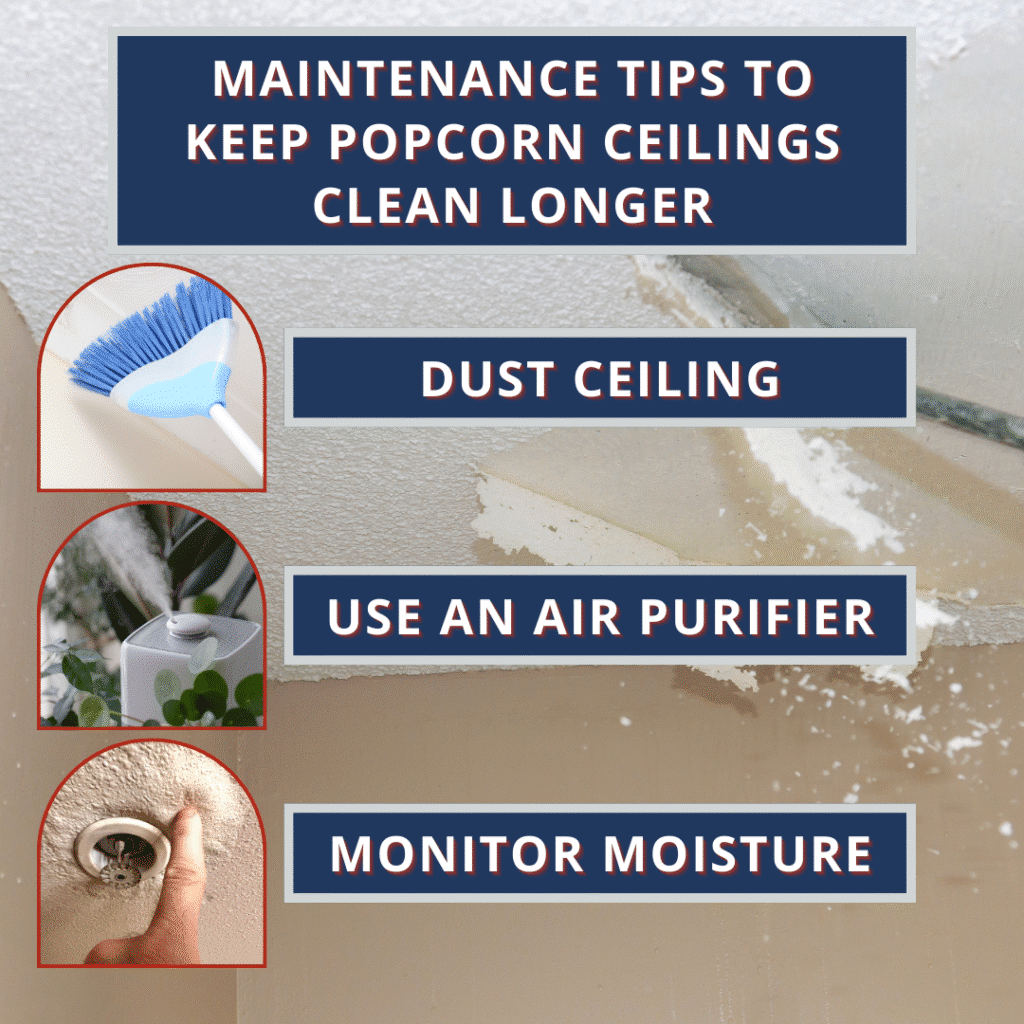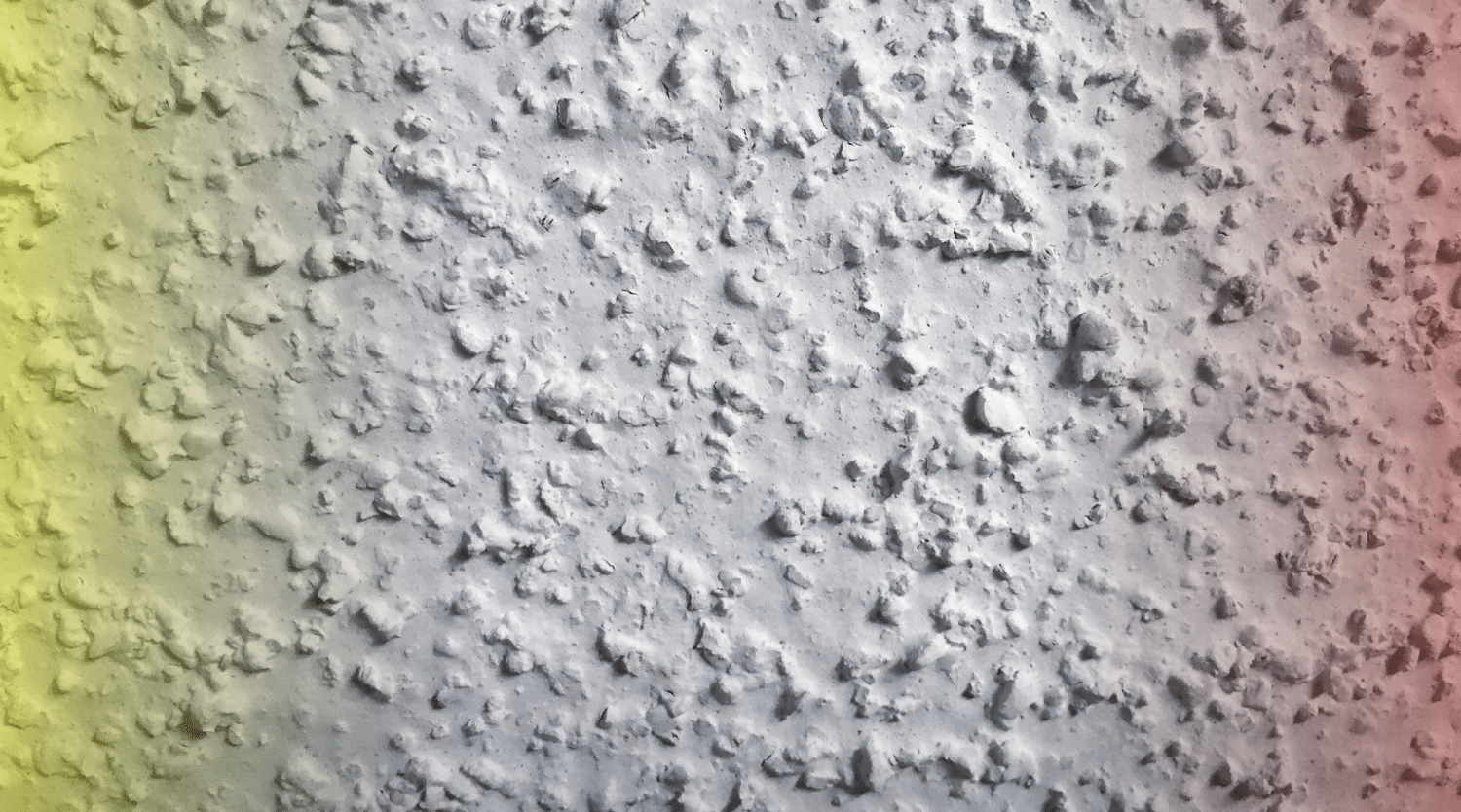Anyone who’s ever tried knows the patience it takes to clean a popcorn ceiling, but it doesn’t have to be stressful.
The trick is to use gentle tools and light cleaning methods so the textured surface doesn’t crumble or sag. With the right approach, you can remove dust, stains, and cobwebs safely and keep your ceilings looking fresh.
What Is a Popcorn Ceiling and Why Does It Matter?
Popcorn ceilings, also called acoustic or stipple ceilings, were popular from the 1950s through the 1980s. They were sprayed on with a special mixture that gave the ceiling a bumpy texture. Builders loved them because they were cheap, helped with soundproofing, and hid flaws in the ceiling.

For homeowners, they can be a mixed bag. On the one hand, popcorn ceilings can give a retro look that many enjoy.
On the other hand, they are harder to clean and often trap dust. If your home was built before 1980, there’s also a chance the texture contains asbestos.
That’s why knowing how to clean them properly and when to call for help matters for both safety and home value.
Safety tip: Never scrape or sand a popcorn ceiling without testing for asbestos. A professional inspection is the safest way to confirm.
How Popcorn Ceilings Impact Home Health
Popcorn ceilings aren’t just a style concern. Their texture creates small grooves that collect dust, cobwebs, and even allergens. Over time, these particles can affect indoor air quality. If you or someone in your home struggles with asthma or allergies, the ceiling may be adding to the problem.
Another health concern is mold. Popcorn ceilings are porous, which means they absorb moisture easily. If your home has leaks or high humidity, water stains may form. Left untreated, those stains can lead to mold growth. Mold spores in the air can trigger allergy-like symptoms and, in some cases, more serious health issues.
If you notice dark patches, discoloration, or a musty smell near the ceiling, don’t just clean it; get it checked. That way, you’ll know if there’s a bigger issue, like a hidden leak or water damage.
The Value of a Clean Popcorn Ceiling for Your Home
A clean popcorn ceiling isn’t just about appearances. It actually adds value to your home. Buyers notice small details during walkthroughs, and stained ceilings can make a house feel old or poorly maintained.
According to a study from Zillow, 63% of buyers are willing to pay more for a home that looks move-in ready. Something as simple as a fresh, clean ceiling can give buyers confidence that the home has been cared for.
Even if you’re not planning to sell, keeping ceilings clean protects your investment. Dust and stains can weaken the texture over time.
Regular maintenance helps the ceiling last longer, saves money on repairs, and keeps your home looking its best.
How to Clean a Popcorn Ceiling Without Damaging It
Cleaning requires the right tools and a step-by-step plan. Here’s how to do it safely.
Step 1: Prepare the Room
Before you start, set up your space. Move furniture out of the way, or cover it with drop cloths. Lay a tarp or sheet on the floor to catch falling dust.
Wear protective glasses and a dust mask so particles don’t get in your eyes or lungs.
This step might feel like extra work, but it makes cleanup easier and keeps your home safe from falling debris.
Step 2: Dust and Remove Loose Debris
Use a vacuum with a soft brush attachment, or a microfiber duster with an extension pole. Start in one corner and work across the ceiling slowly. The goal is to lift away cobwebs and dust without pressing too hard.
If you notice the texture flaking off, stop and adjust your method. Light pressure is key.
Step 3: Spot Clean Stains
For small stains, mix warm water with a drop of dish soap or vinegar. Use a sponge or spray bottle to lightly apply the solution, then blot with a soft cloth. Do not scrub. Scrubbing can loosen or flatten the texture.
Always test your cleaning solution in a hidden corner before applying it to visible areas. Some ceilings may react differently to moisture.
Step 4: Address Stubborn Stains Safely
If stains don’t come off with mild soap, try a baking soda paste. Apply it gently to the stain, let it sit for a few minutes, then blot with a damp sponge.
For water stains, cleaning may not be enough. You may need to repaint the ceiling with a stain-blocking primer. Choose a primer designed for textured surfaces for the best results.
Common Mistakes to Avoid When Cleaning Popcorn Ceilings
Homeowners often make mistakes that end up damaging the ceiling. Here’s what to avoid:
- Using too much water: Popcorn ceilings absorb moisture quickly, which can make the texture sag or peel.
- Scrubbing aggressively: Rubbing the ceiling breaks off pieces of texture. Always blot gently instead.
- Skipping safety checks: If your ceiling may contain asbestos, don’t attempt DIY cleaning without testing.
- Painting over dirt: Paint won’t stick to dust or grease. Always clean before repainting.
By avoiding these common errors, you’ll save yourself from costly repairs later.
Maintenance Tips to Keep Popcorn Ceilings Clean Longer
Keeping up with light maintenance means you won’t have to deep clean as often. Here are a few simple habits:
- Dust ceilings monthly with a microfiber duster or vacuum attachment.
- Use an air purifier to reduce dust in your home.
- Watch for leaks around bathrooms, kitchens, or roofs that could cause stains.
- Keep indoor humidity around 30–50% to prevent mold.
These small steps help your ceiling stay clean and extend its lifespan.

When to Call a Professional
Not every ceiling issue can be solved with DIY cleaning. Call a professional if:
- Your home was built before 1980, and asbestos may be present.
- You notice mold, water damage, or spreading stains.
- The ceiling feels soft or saggy, which could mean water damage.
- You plan to sell your home and want to make sure the ceilings pass inspection.
A home inspector can check for hidden issues behind the stains. They can also test for asbestos or mold, which are problems best handled by licensed pros.
Related Questions
Can you paint a popcorn ceiling after cleaning?
Yes. Once the ceiling is dry, you can paint it to refresh the look. A thick-nap roller or sprayer works best to cover the textured surface.
How do you know if your popcorn ceiling has asbestos?
Only a lab test can confirm asbestos. If your home is older, avoid disturbing the ceiling until a professional tests it.
Does cleaning popcorn ceilings increase home value?
Yes. Clean ceilings make your home look well-maintained and can improve its appeal during resale or inspections.
Conclusion
Popcorn ceilings may be tricky, but they can be cleaned without damage if you use the right steps. A clean ceiling improves your home’s air quality, appearance, and even resale value.
If you notice water stains, mold, or suspect asbestos, don’t risk it with DIY methods. Schedule a professional home inspection with P.I. Home Inspection Services to make sure your ceiling is safe and your home stays in top shape.

